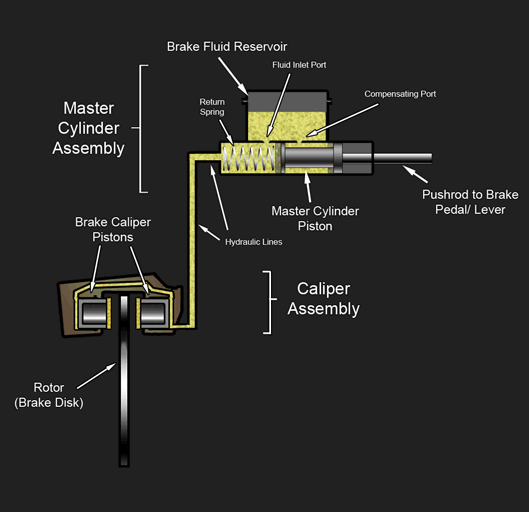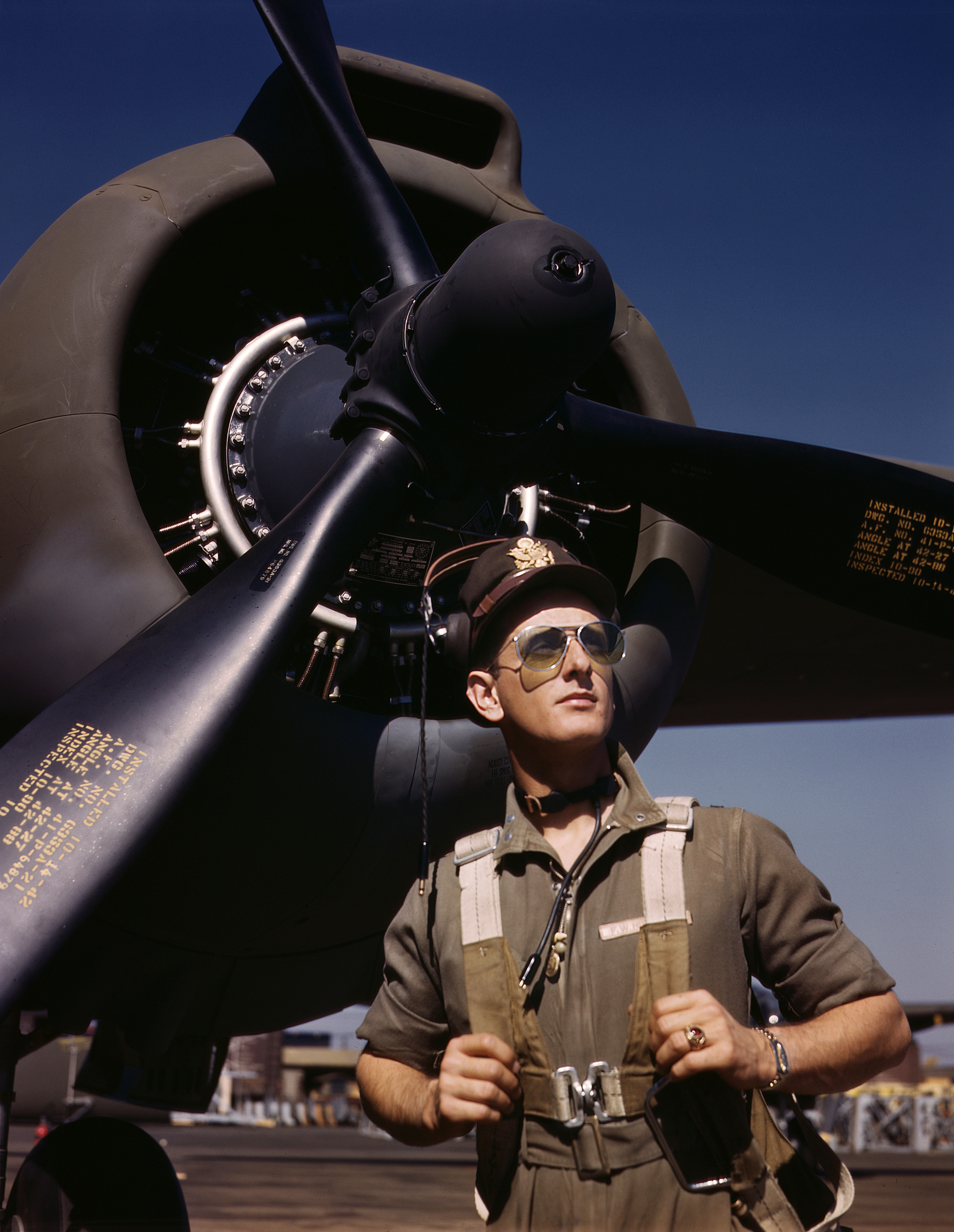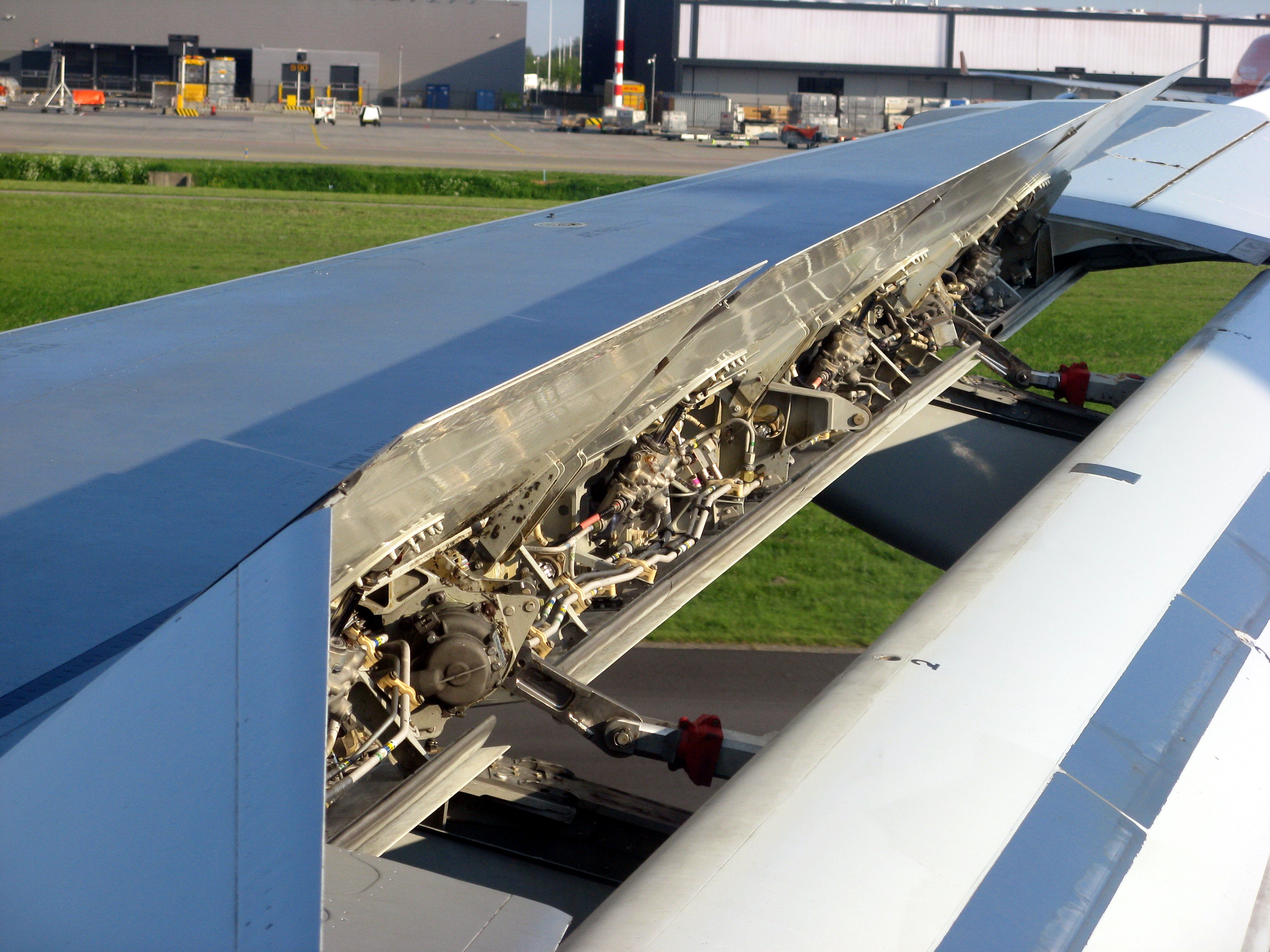|
Autobrake
An autobrake is a type of automatic wheel-based hydraulic brake system for advanced airplanes. The autobrake is normally enabled during takeoff and landing procedures, when the aircraft's longitudinal deceleration system can be handled by the automated systems of the aircraft itself in order to keep the pilot free to perform other tasks. Landing While landing, the autobrake can help to free up the pilot to allow monitoring other systems (such as the execution of the landing flare). There are usually several settings for the rate of deceleration. The selection of these settings are normally undertaken on the aircraft instrument panel before landing. Aircraft have multiple autobrake settings, with higher settings providing more aggressive braking forces. These are set based on factors such as runway length or desired exit point from the runway. When the landing feature of the autobrake is engaged, the aircraft automatically engages pressurized wheel braking upon touchdown to the la ... [...More Info...] [...Related Items...] OR: [Wikipedia] [Google] [Baidu] |
Rejected Takeoff
In aviation, a rejected takeoff (RTO) or aborted takeoff is the situation in which the pilot decides to abort the takeoff of an airplane after initiating the takeoff roll but before the airplane leaves the ground. Reasons to perform a rejected takeoff vary but are usually related to a suspected or actual problem with the aircraft, such as an engine failure; fire; incorrect configuration; aircraft control issue; unusually slow acceleration; automated warning signal(s) indicating a critical system failure; environmental conditions such as predictive windshear; or an instruction from air traffic control. There are three phases of a takeoff. In the low-speed regime, usually below 80 kts or so, the takeoff will be rejected even for minor failures. In the high-speed regime, above usually 80 kts but below V1, minor problems are ignored, but the takeoff will still be rejected for serious problems, in particular for engine failures. The takeoff decision speed, known as V1, is calculated ... [...More Info...] [...Related Items...] OR: [Wikipedia] [Google] [Baidu] |
Landing
Landing is the last part of a flight, where a flying animal, aircraft, or spacecraft returns to the ground. When the flying object returns to water, the process is called alighting, although it is commonly called "landing", "touchdown" or " splashdown" as well. A normal aircraft flight would include several parts of flight including taxi, takeoff, climb, cruise, descent and landing. Aircraft Aircraft usually land at an airport on a firm runway or helicopter landing pad, generally constructed of asphalt concrete, concrete, gravel or grass. Aircraft equipped with pontoons ( floatplane) or with a boat hull-shaped fuselage (a flying boat) are able to land on water. Aircraft also sometimes use skis to land on snow or ice. To land, the airspeed and the rate of descent are reduced such that the object descends at a low enough rate to allow for a gentle touch down. Landing is accomplished by slowing down and descending to the runway. This speed reduction is accomplished by r ... [...More Info...] [...Related Items...] OR: [Wikipedia] [Google] [Baidu] |
Hydraulic Brake
A hydraulic brake is an arrangement of braking mechanism which uses brake fluid, typically containing glycol ethers or diethylene glycol, to transfer pressure from the controlling mechanism to the braking mechanism. History During 1904, Frederick George Heath, Redditch, England devised and fitted a hydraulic (water/glycerine) brake system to a cycle using a handlebar lever and piston. He obtained patent GB190403651A for “Improvements in hydraulic actuated brakes for cycles and motors”, as well as subsequently for improved flexible rubber hydraulic pipes. In 1908, Ernest Walter Weight of Bristol, England devised and fitted a four-wheel hydraulic (oil) braking system to a motor car. He patented it in Great Britain (GB190800241A) in December 1908, later in Europe and the USA and then exhibited it at the 1909 London Motor Show. His brother, William Herbert Weight improved the patent (GB190921122A) and both were assigned to the Weight Patent Automobile Brake Ltd. of 23 Bridge Stre ... [...More Info...] [...Related Items...] OR: [Wikipedia] [Google] [Baidu] |
Airplanes
An airplane (American English), or aeroplane (Commonwealth English), informally plane, is a fixed-wing aircraft that is propelled forward by thrust from a jet engine, propeller, or rocket engine. Airplanes come in a variety of sizes, shapes, and wing configurations. The broad spectrum of uses for airplanes includes recreation, transportation of goods and people, military, and research. Worldwide, commercial aviation transports more than four billion passengers annually on airliners and transports more than 200 billion tonne-kilometersMeasured in RTKs—an RTK is one tonne of revenue freight carried one kilometer. of cargo annually, which is less than 1% of the world's cargo movement. Most airplanes are flown by a pilot on board the aircraft, but some are designed to be unmanned aerial vehicle, remotely or computer-controlled such as drones. The Wright brothers invented and flew the Wright Flyer, first airplane in 1903, recognized as "the first sustained and controlled heavier- ... [...More Info...] [...Related Items...] OR: [Wikipedia] [Google] [Baidu] |
Takeoff
Takeoff is the phase of flight in which an aerospace vehicle leaves the ground and becomes airborne. For aircraft traveling vertically, this is known as liftoff. For aircraft that take off horizontally, this usually involves starting with a transition from moving along the ground on a runway. For balloon (aircraft), balloons, helicopters and some specialized fixed-wing aircraft (VTOL aircraft such as the Hawker Siddeley Harrier, Harrier and the Bell Boeing V22 Osprey), no runway is needed. Horizontal Power settings For light aircraft, usually full power is used during takeoff. Large transport category (airliner) aircraft may use a flex temp, reduced power for takeoff, where less than full power is applied in order to prolong engine life, reduce maintenance costs and reduce noise emissions. In some emergency cases, the power used can then be increased to increase the aircraft's performance. Before takeoff, the engines, particularly piston engines, are routinely run up at high po ... [...More Info...] [...Related Items...] OR: [Wikipedia] [Google] [Baidu] |
Aviator
An aircraft pilot or aviator is a person who controls the flight of an aircraft by operating its directional flight controls. Some other aircrew members, such as navigators or flight engineers, are also considered aviators because they are involved in operating the aircraft's navigation and engine systems. Other aircrew members, such as drone operators, flight attendants, mechanics and ground crew, are not classified as aviators. In recognition of the pilots' qualifications and responsibilities, most militaries and many airlines worldwide award aviator badges to their pilots. Definition The first recorded use of the term ''aviator'' (''aviateur'' in French) was in 1887, as a variation of ''aviation'', from the Latin ''avis'' (meaning ''bird''), coined in 1863 by in ''Aviation Ou Navigation Aérienne'' ("Aviation or Air Navigation"). The term ''aviatrix'' (''aviatrice'' in French), now archaic, was formerly used for a female pilot. The term ''aviator'' (''aviateur'' ... [...More Info...] [...Related Items...] OR: [Wikipedia] [Google] [Baidu] |
Landing Flare
The landing flare, also referred to as the round out, is a maneuver or stage during the landing of an aircraft. The flare follows the final approach phase and precedes the touchdown and roll-out phases of landing. In the flare, the nose of the plane is raised, slowing the descent rate and therefore creating a softer touchdown, and the proper attitude is set for touchdown. In the case of tailwheel landing gear-equipped aircraft, the attitude is set for touchdown on the main (front) landing gear first. In the case of tricycle gear-equipped aircraft, the attitude is set for touchdown on the main (rear) landing gear. In the case of monowheel gear-equipped gliders, the flare consists only of leveling the aircraft. In parachuting, the flare is the part of the parachute landing fall preceding ground contact and is executed about above ground. During a helicopter A helicopter is a type of rotorcraft in which Lift (force), lift and thrust are supplied by horizontally ... [...More Info...] [...Related Items...] OR: [Wikipedia] [Google] [Baidu] |
Runway
In aviation, a runway is an elongated, rectangular surface designed for the landing and takeoff of an aircraft. Runways may be a human-made surface (often asphalt concrete, asphalt, concrete, or a mixture of both) or a natural surface (sod, grass, soil, dirt, gravel, ice, sand or road salt, salt). Runways, taxiways and Airport apron, ramps, are sometimes referred to as "tarmac", though very few runways are built using Tarmacadam, tarmac. Takeoff and landing areas defined on the surface of water for seaplanes are generally referred to as waterways. Runway lengths are now International Civil Aviation Organization#Use of the International System of Units, commonly given in meters worldwide, except in North America where feet are commonly used. History In 1916, in a World War I war effort context, the first concrete-paved runway was built in Clermont-Ferrand in France, allowing local company Michelin to manufacture Bréguet Aviation military aircraft. In January 1919, aviation p ... [...More Info...] [...Related Items...] OR: [Wikipedia] [Google] [Baidu] |
Drag (physics)
In fluid dynamics, drag, sometimes referred to as fluid resistance, is a force acting opposite to the direction of motion of any object moving with respect to a surrounding fluid. This can exist between two fluid layers, two solid surfaces, or between a fluid and a solid surface. Drag forces tend to decrease fluid velocity relative to the solid object in the fluid's path. Unlike other resistive forces, drag force depends on velocity. Drag force is proportional to the relative velocity for low-speed flow and is proportional to the velocity squared for high-speed flow. This distinction between low and high-speed flow is measured by the Reynolds number. Drag is instantaneously related to vorticity dynamics through the Josephson-Anderson relation. Examples Examples of drag include: * Net force, Net Aerodynamic force, aerodynamic or Fluid dynamics, hydrodynamic force: Drag acting opposite to the direction of movement of a solid object such as cars, aircraft, and boat hulls. * Viscou ... [...More Info...] [...Related Items...] OR: [Wikipedia] [Google] [Baidu] |
Reverse Thrust
Reverse or reversing may refer to: Arts and media *Reverse (Eldritch album), ''Reverse'' (Eldritch album), 2001 *Reverse (2009 film), ''Reverse'' (2009 film), a Polish comedy-drama film *Reverse (2019 film), ''Reverse'' (2019 film), an Iranian crime-drama film *Reverse (Morandi album), ''Reverse'' (Morandi album), 2005 *Reverse (TV series), ''Reverse'' (TV series), a 2017–2018 South Korean television series *"Reverse", a 2014 song by SomeKindaWonderful *REVERSE art gallery, in Brooklyn, NY, US *Reverse tape effects including backmasking, the recording of sound in reverse * ''Reversing: Secrets of Reverse Engineering'', a book by Eldad Eilam *''Tegami Bachi: REVERSE'', the second season of the ''Tegami Bachi'' anime series, 2010 Driving * Manual_transmission#Reverse gear, Reverse gear, in a motor or mechanical transmission * Reversing (vehicle maneuver), reversing the direction of a vehicle * Turning in the road, Turning a vehicle through 180 degrees Sports and games *Reverse (A ... [...More Info...] [...Related Items...] OR: [Wikipedia] [Google] [Baidu] |
Spoiler (aeronautics)
In aeronautics, a spoiler (sometimes called a lift spoiler or lift dumper) is a device which increases the Drag (physics), drag and decreases the lift (force), lift of an airfoil in a controlled way. Most often, spoilers are hinged plates on the top surface of a wing that can be extended upward into the airflow to ''spoil'' the streamline flow. By so doing, the spoiler creates a controlled Stall (flight), stall over the portion of the wing behind it, greatly reducing the lift of that wing section. Spoilers differ from air brake (aeronautics), airbrakes in that airbrakes are designed to increase drag without disrupting the lift distribution across the wing span, while spoilers disrupt the lift distribution as well as increasing drag. However, flight spoilers are routinely referred to as "speed brakes" on transport aircraft by pilots and manufacturers, despite significantly reducing lift. Spoilers fall into two categories: those that are deployed at controlled angles during flig ... [...More Info...] [...Related Items...] OR: [Wikipedia] [Google] [Baidu] |
Airbus A300-600
The Airbus A300 is Airbus' first production aircraft and the world's first twin-engine, double-aisle (wide-body) airliner. It was developed by ''Airbus Industrie GIE'', now merged into Airbus SE, and manufactured from 1971 to 2007. In September 1967, aircraft manufacturers in France, West Germany and the United Kingdom signed an initial memorandum of understanding to collaborate to develop an innovative large airliner. The French and West Germans reached a firm agreement on 29 May 1969, after the British withdrew from the project on 10 April 1969. A new collaborative aerospace company, ''Airbus Industrie GIE'', was formally created on 18 December 1970 to develop and produce it. The A300 prototype first flew on 28 October 1972. The first twin-engine widebody airliner, the A300 typically seats 247 passengers in two classes over a range of 5,375 to 7,500 km (2,900 to 4,050 nmi; ). Initial variants are powered by General Electric CF6-50 or Pratt & Whitney JT9D turb ... [...More Info...] [...Related Items...] OR: [Wikipedia] [Google] [Baidu] |







